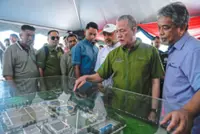The oldest religious monument found at Sungai Batu.
DID you know that Kedah used to go by various names, like “Kalat”, “Kalah” and “Kataram”? Foreign traders were the ones who gave the place these names during ancient times, as some had difficulty pronouncing “Kedah”. Many of these traders came from India, Europe, the Middle East and China, and traded in mainly iron and spices.
Kedah certainly had a thriving economy back then, and was even a powerful kingdom for some centuries.
Today, tucked in the oil palm plantations in Sungai Batu, you can find physical evidence of “Kedah Tua”, the oldest civilisation in South-East Asia. Scientists and researchers have been working on the Sungai Batu Archaeological Complex since 2009, and they hope to continue for as long as they can.
We recently met with archaeologist Professor Datuk Dr Mokhtar Saidin, former director of the Global Archaeological Research Centre of Universiti Sains Malaysia (USM), at the excavation site. Prof Mokhtar, 60, was the head of the project; he also led various other research projects like the Kampung Temelong prehistoric site in Lenggong (Perak) and the Tingkayu archaeological complex in Sabah.
According to him, over thousands of years ago, before the formation of the Kedah government system in the early 1000s, this part of Malaya was known as Kedah Tua. The area was brimming with iron smelting activities, and the team of researchers has found physical evidence of this.
One day, while sifting through some soil, the team unearthed an ancient artefact – a smelted iron. After analysing it, the piece was found to be from as far back as 788BC, making it the oldest artefact ever discovered at the site so far.
The team has since discovered other remains of ancient treasures at the archaeological complex such as trading ports, iron smelting workshops and a ritual monument, as well as jetties, or at least parts of them.
With the help of drone shots, geophysical instruments, remote sensing techniques and core drilling, Prof Mokhtar and his team successfully mapped 97 sites within the 4sq km strip of land.
“So far, we have dug up 57 sites, and we are still working on other sites every day,” he said, adding that he used carbon dating to determine the age of the smelted iron.
Sungai Batu was where all the iron trading took place. A total of eight iron smelting workshops were found here. Being one of the primary trading activities, iron was a major trade in many parts of the world. Its various uses for chariots and weapons made it a highly sought-after material.
Smelting the iron, however, was no easy feat, taking into account that everything had to be done manually. Workers had to be able to withstand the intense heat from the furnace and hot melted iron, coupled with the long hours of labour.
“From our own experiment, we ascertained that the process would have taken approximately eight hours of continuous work to complete,” said Prof Mokhtar.
Of all the various ancient tools that the research team found, the tuyere captured Prof Mokhtar’s attention the most.
“Tuyere is a cylindrical-shaped tool used for creating and maintaining the heat in the furnace during the smelting process. We excavated more than two million tuyeres! All of them were identical, which means they must have been produced with a mould,” he shared.
“Unfortunately, after years of excavating work, we still can’t find any trace of the mould.”
Buried treasures
There are also evidence of Hindu and Buddhist influences in Kedah Tua in the form of temples or candi, which were found in various parts of the area, specifically in Lembah Bujang and Sungai Batu.
Prof Mokhtar himself excavated a candi at Sungai Batu, and also found some pottery carved with religious art that were symbolic of animism and Buddhism practices.
He said the Sungai Batu candi is rather unique. “There are three structural elements, with a round base from 110AD, a square structure on top and a smaller circular formation above it originating from the 8th century.
“The square and circular-shaped architecture was believed to be a Buddhist stupa, while the base and the pottery found in the vicinity indicates animism,” he added.
To the untrained eye, the stupa may look like a perfectly-assembled brick formation, but Prof Mokhtar, who was our guide for the day, explained what it was. “Having knowledgeable guides can help one to better understand and foster an appreciation of our historical past.”
The Lembah Bujang Archaeological Museum, located within the Kedah Tua Archaeological Site, is the place to go if you want to dive deeper into the history of the ancient kingdom. The museum also houses four candi that were found from different sites in the area. Three of these are reconstructions, while the Candi Bukit Batu Pahat is in its original form.
Archaeologist Dr Mohd Hasfarisham Halim, 37, is the guide at the museum. If you speak to him, he will tell you more about the candi, and all the artefacts that have been found so far in archaeological site. According to him, the candi were built using materials available in the area, such as clay, laterite, granite and gravel.
The type of materials can also help to indicate the period the temples were constructed.
There’s a gallery where artefacts are on display. Among them are trade items like iron, ceramics, beads and pottery and religious sculptures.
“In the past, the different shapes of beads were produced with various techniques, like pulling, rolling and mosaic, as well as gold glass. Iron ore such as magnetite and hematite, for instance, is a raw material for iron ingot. They will first be melted and then processed into iron ingot for export,” Dr Hasfarisham said.
All dried up
Another important find at the area was the port administration site, said to be the heart of all trading activities during the Kedah Tua period.
“It is akin to today’s Putrajaya, the administrative capital of the country. The earliest port discovered here was over 2,500 years old,” said Prof Mokhtar, who found 12 ports at Sungai Batu.
The place was managed by the syahbandar, or portmaster, who was hired to oversee administrative operations.
Back in the day, food was prepared in the brick building as well. According to Prof Mokhtar, the research team spotted signs of a kitchen in the form of cooking ash and charcoal, which were used to cook.
Jetties, meanwhile, served as a hub for barter trade. The archaeologists found not one but 11 jetty remains at the site, too.
“The items traded were usually iron ingots and other foreign goods brought in by the traders,” the professor said.
Elephants were believed to be the primary form of transportation to carry the raw materials across rivers.
Today, these rivers no longer exist. Prof Mokhtar explained: “Over centuries ago, this entire area was a 30m-deep river and lake, until water started drying up.”
Based on historical records, the smelting industry came to an end during the Chola Invasion of Kadaram (now Kedah) – said to have taken place in 1025. This caused the people to abandon the place and move elsewhere. Ships also eventually ended up at the sea bed as the water level in Sungai Batu receded.
The ships used by the traders to export iron that were also docked at the bay, are today buried beneath the mud. Prof Mokhtar said that anomalies from geophysical studies showed that there may be five sunken ships at the site in Sungai Batu.
In 2012, the team tried their hand at excavating the vessels. However, they encountered several setbacks, resulting in them only being able to explore one of the said vessels. They found the ship’s mast and boat nails.
“We had to call off the project due to budget constraints and safety measures. Diving into the soft mud will pose a serious threat to the person’s life,” he said.
The archaeologist said the team intends to keep the vessel where it is, to help protect it from further damage. “Sudden exposure to air can destroy the wood,” Prof Mokhtar added.
He is hopeful that with sufficient funding and technology, more studies relating to the shipwrecks at the site can be conducted in the future as Sungai Batu has big potential as a destination for archaeological tourism.
“The thing about archaeology is that it’s ever changing, as you’ll have new findings along the way.
“If the site is preserved, we may just be able to reveal an entire kingdom,” Prof Mokhtar concluded.
Travel tips
The Sungai Batu Archaeological Complex is located about 80km from Kedah capital, Alor Setar, and 10km from Sungai Petani.
You can drive to the site yourself, although we recommend getting a local guide or engaging the services of a local tour agency.
Visitors can try their hand at brick-making and excavating work.
A toolkit with a trowel, sieves and a brush will be provided. The brush will be used to clean or remove the debris off the relics... just like a real researcher!
The place is open daily from 9am-4.30pm. For more information, check out the Persatuan AncKed Sungai Batu on social media (Facebook: @ANCKED, TikTok: @arkeopelancongank). You can also go to facebook.com/sungaibatutamadunterawalasiatenggara.













